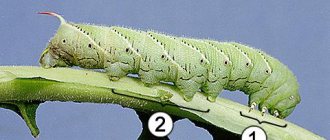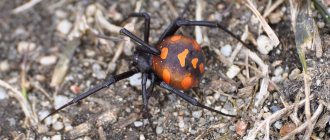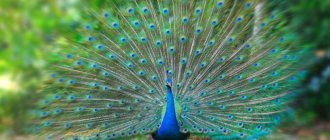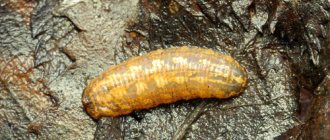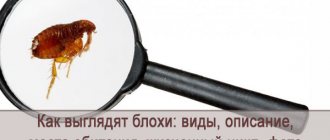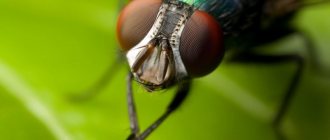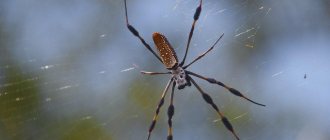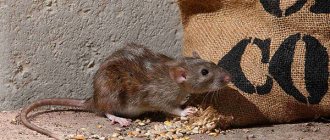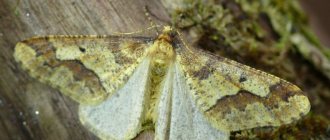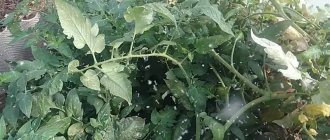- Wild animals
- >>
- Arachnids
Banana spider , or as it is also called, the golden spider, or the wandering soldad spider, is a poisonous spider.
In 2022, it even entered the Guinness Book of Records due to the strong toxicity of its poison. Modern medicine has made great strides, thanks to which doctors have learned to make an antidote. This helps reduce the number of deaths after an arthropod bite. The spider is called a banana spider because it is often found under the skin of the fruit, or inside a bunch of bananas. Thus, it spreads almost throughout the world and poses a great danger.
Origin of the species and description
Photo: Banana spider
The banana spider belongs to the arthropod arachnids, classified in the order Spiders, family Nephilidae, genus Nephila.
Spiders are unique representatives of flora and fauna. Only they tend to weave webs and have 8 legs. These features prompted ancient scientists to believe that these creatures did not originate on Earth, but came here from a completely different planet. However, the subsequently found remains of the ancient ancestors of modern spiders made it possible to refute this theory.
Modern scientists still cannot determine the exact period of appearance of spiders on earth. This is due to the fact that the chitinous shell of arachnids is destroyed quite quickly. The exception is the few remains of the ancient ancestors of modern arachnids, which have survived to this day thanks to amber or pieces of frozen resin.
Video: Banana Spider
According to a few finds, scientists were able to name the approximate period of the appearance of arachnids - it is approximately 200-250 million years ago. The very first spiders looked very different from modern representatives of this species. They had very small body sizes and a tail section, which was designed for weaving webs. The process of formation of sticky threads was most likely involuntary. The threads were not used to weave webs, but to line their burrows and preserve cocoons.
Scientists call Gondwana the birthplace of arachnids. With the advent of Pangea, the arachnids that existed at that time quickly spread across various regions of the earth. The subsequent ice ages significantly narrowed the habitat regions of arachnids on earth.
For the first time, the features of the life activity and appearance of the banana spider were described by the German researcher Maximilian Perti in 1833. He gave him a name, which, translated from Greek, was interpreted as “killer.”
Properties of spider silk
When the French began to explore the possibility of industrial use of silkworm spiders, they conducted a number of experiments. In particular, it was found that it was impossible to develop a colony in France. Over the entire country there simply were not as many insects as would be needed to feed the number of weavers required for manufacture. Therefore, production remained artisanal, very little silk was produced, and its prices were truly fabulous.
Already in our time, scientists have determined that a thread 0.1 mm thick can withstand up to 80 grams! For comparison: the same silkworm thread can withstand no more than 15 g.
The strength of the fabric is also unusually high. For the same thickness, it is much stronger than that obtained from the silk of the mulberry insect, and for the same strength, spider silk is much thinner. Moreover, you can take the thread not only from the cocoon or from the web itself, but also directly from the spider. One individual can produce up to 4 km of thread in a month (the record for an unwound mulberry cocoon is 500 m).
Appearance and features
Photo: Banana spider in America
The appearance of banana spiders does not have any specific features or distinctive features. It can easily be confused with any other spider. This type of spider has quite pronounced sexual dimorphism - females are almost twice as large as males in size and body weight.
Distinctive features of the appearance of wandering soldiers:
- body dimensions – 1.5-4.5 centimeters;
- long limbs, the size of which in some individuals reaches up to 15 centimeters. The chelicerae in most individuals are brown or dark red. This scares off other predators who want to hunt spiders. The other limbs have transverse rings that are darker in color;
- the body is represented by two sections: the convex abdomen and the cephalothorax;
- the body is covered with thick, stiff hairs;
- the color is dark gray, close to black. Some individuals have a dark red or burgundy color;
- The color of an arthropod depends on the region and living conditions, since the color of the body serves as a camouflage function;
- a dark stripe runs along the body.
Long limbs are a distinctive feature of the banana spider. They are used not only as a means of transportation, but also as organs of touch and smell. They contain many hypersensitive receptors. There are 8 pairs of visual organs on the head. Thanks to so many organs of vision, they are provided with a 360-degree view. They can clearly distinguish not only clear pictures, but also shadows and individual silhouettes. Banana spiders have an excellent, instant reaction to movement.
Interesting fact: A distinctive feature of a wandering soldier is considered to be a pose that is characteristic only of him. When attacked, he stands on his hind legs, lifts up and straightens his front legs. In this position, he is ready for a lightning attack and injection of highly toxic poison.
What to do when meeting with heirakantium
To avoid the unpleasant consequences of an encounter with a spider, you need to take into account a number of simple rules.
In room
Drive it out only if you catch it with a container or thick cloth.
In the garden
Carry out work with gloves in case of a possible encounter with a spider. If he is noticed, avoid him.
On the body
If the spider has already landed on things or a body, do not make sudden movements or try to kill it. It is best to gently shake off the animal.
If the spider has already bitten
If the meeting has already taken place and is not in favor of the person, a number of decisive actions need to be taken.
- Wash the wound site with soap and apply a cold compress.
- If you raise the limb upward, you can reduce the inflammatory process.
- In case of allergies, take an analgesic and an antihistamine.
- If symptoms persist, consult a doctor.
Where does the banana spider live?
Photo: Banana spider in bananas
The largest number of banana spiders is concentrated in South America. However, the banana spider can also be found in other regions.
Geographical regions of the wandering soldier's habitat:
- Costa Rica;
- Argentina;
- Colombia;
- Venezuela;
- Ecuador;
- Bolivia;
- Australia;
- Madagascar;
- Brazil;
- Paraguay;
- Panama.
The exception is the northeastern region of the South American region. Often found as a habitat in equatorial rainforests. The leaves of various plants, stuck together, provide a cozy and safe refuge for arachnids. This is how insects get onto banana trees, and along with the leaves, onto fruit bunches. A sign of their presence is considered to be white mold or cobwebs, as well as dark tubercles under the skin of the fruit.
Interesting fact: In the body of banana spiders, unlike other types of spiders, there are not one, but seven such glands. Each of them performs its own function. There is a gland responsible for protecting cocoons, or fixing the victim, as well as glands designed to form a strong web.
In Russia, spiders are practically not found in natural conditions. They are often kept as pets. It is unusual for spiders to occupy burrows; they lead a nomadic lifestyle and can hide under stones and snags. In the process of moving, spiders often climb into human homes. Traveling soldiers do not tolerate extreme heat well, trying to hide in secluded corners, which poses a great danger to the people living in the house.
Now you know where the banana spider lives. Let's see what he eats.
Tegenaria wall
Tegenaria wall
Tegenaria is also called the giant house spider - the span of the legs of these spiders reaches 13 cm.
These spiders are excellent at running short distances. Cannibalism is very common among them. The habitat of this type of spider is Africa and Asia, most often they can be found in caves or abandoned buildings, however, nowadays these spiders are rare.
What does a banana spider eat?
Photo: Banana spider
Wandering soldiers are rightfully considered omnivorous insects. They feed on everything they can catch in their fishing nets. They also do not disdain food of plant origin - bananas, or the fruits of other fruit trees.
What serves as food supply:
- beetles;
- midges;
- locusts;
- caterpillars;
- insects;
- other, smaller arachnids;
- lizards;
- various types of amphibians;
- various types of small birds;
- snakes;
- rodents.
Spiders use a variety of means to obtain a food source. They can weave incredibly strong trapping nets, with the help of which they provide themselves with food.
Interesting fact: In some cases, the size of the poutine can reach 2 meters! It is incredibly durable, as it is capable of holding a bird, small lizard or snake caught in it.
Spiders can also hunt prey of their choice. They choose a potential victim, overtake it in the blink of an eye, stand on their hind legs and attack, spraying deadly poison. Under the influence of the poison, the victim is paralyzed and its insides are digested and melted. After some time, the spiders simply drink the internal contents of their prey.
The venom of banana spiders is considered very highly toxic. To kill an average-sized mouse, they only need 6 micrograms of poisonous secretion. However, having caught the next victim in her strong web, the female spider is in no hurry to kill her. The prey is paralyzed by injecting poison and wrapped in a cocoon of spider webs. After this, it is suspended while still alive. This way the loot can be stored for some time.
Bite danger to humans
Depending on the species and habitat, the venom glands of the banana spider have varying degrees of toxicity.
A person is not a potential victim for a spider, but its bite can be very painful and manifests itself in the following symptoms:
- burning pain in the bite area;
- nausea and dizziness;
- thirst and constant dry mouth;
- swelling in the wound area;
- sharp pain in the abdomen.
When the body is exposed to banana spider venom, some people experience severe allergic reactions, manifested in difficulty breathing, rashes and swelling of the mucous membranes.
Good to know! In other cases, all symptoms of poisoning disappear and 24 hours after intoxication, only a red dot or a small scar remains on the skin.
Features of character and lifestyle
Photo: Banana spider in nature
Spiders spend most of their time on the web they weave. It can be located in residential buildings or non-residential premises. They prefer to hunt in the dark. It is during this period that their web casts silver reflections that attract potential victims. Banana spiders are unique web-weavers. Special glands in their body synthesize a specific liquid, which, when muscle fibers contract, turns into a web.
Weaving webs is done exclusively by females. Males exist only to procreate. Males feed on the remains of the female's prey. Banana spiders differ from their relatives in their speed of movement and lightning-fast reaction. Spiders are not afraid to attack even those representatives of the local flora and fauna that surpass them in size, strength and power. Most often, in a seemingly unequal fight, spiders manage to win, as they instantly inject their highly toxic poison. Science knows of cases where spiders managed to defeat an adult rat.
Spiders do not tend to lead a sedentary lifestyle. They constantly wander, for which they received their second name. They often have to travel long distances. Spiders have the ability not only to run very fast, but also to jump quite high. The greatest activity is observed at night. During the day, spiders hide in the foliage, on the branches of bushes and trees near the web they weave. The hairs, or bristles, which are located on the limbs, allow them to respond to the slightest vibrations and movements of the spider threads.
Interesting Facts
This type of spider was discovered not by biologists, but by paleontologists. Back in the nineteenth century, several varieties were discovered trapped in amber. For a long time, experts considered the species extinct until they discovered living individuals in nature.
Japanese mythology contains legends of a werewolf who uses nephil spiders to transform into a beautiful woman and attract men to her.
It is noteworthy that nephiles are carefully hidden, which makes it very difficult to see them in the wild. Perhaps it is precisely because of this that spiders remained unnoticed and unstudied for many years.
Social structure and reproduction
Photo: Banana spider
Males are much smaller than females in size and weight. Before mating, they tend to attract the attention of a potential partner with a peculiar dance and tap dancing with their limbs. After the mating process is completed, the egg laying period begins. The female wraps the laid eggs in a cocoon of cobwebs and hangs them with strong threads. Females zealously guard their cocoons until the spiderlings hatch from them. After 20-25 days from the moment they are placed in the cocoon, small spiders appear from the eggs.
The size of one cocoon is several centimeters. There may be several such cocoons. In total, one female can lay from one and a half to two hundred to several thousand eggs. The mating season of banana spiders most often begins in early April and lasts until the end of spring. After the mating process is completed, each male quickly runs away, since females often simply eat their partners after the completion of the mating season.
Spiders reach sexual maturity at the age of three. During the first 12 months of life, they can withstand up to a dozen molts. With age, the number of moults decreases, and the toxicity of the poison increases. The growth of spiders occurs during the molting period. The average lifespan of one spider in natural conditions is 3-5 years.
LiveInternetLiveInternet
Nephila komaci is the largest species of the genus and the largest spider that weaves trapping webs.
Females reach a leg span of 12 cm, with a body length of 4 cm. Moreover, the web they weave can reach more than one meter in diameter! Males, as is often the case in the world of spiders, are much smaller than females - their body length is about 1 cm, and their leg span is only 2.5 cm.
Interestingly, this type of fart was first identified from museum specimens as a result of the work of scientists with collections at the Research Institute for the Protection of Flora in Pretoria (South Africa) and Vienna (Austria). This happened in 2000. And seven years later, in 2007, the Nephila komaci spider was discovered in the wild in Tembe Elephant Park. It was found by biologists from the Slovenian Academy of Sciences and Arts Matthias Kuntner and Jonathan Coddington, who are employees of the Washington National Museum of Natural History.
It was discovered by biologists from the Slovenian Academy of Sciences and Arts Matthias Kuntner and Jonathan Coddington, who are employees of the Washington National Museum of Natural History.
This species was named after the friend and assistant of one of the discoverers, arachnologist Andrej Komac, who tragically died during the expedition.
As it turned out, the discovery is the first time a new representative of the genus Nephila Leach has been discovered in more than a hundred years. The first spider of this genus was found in 1879 by arachnologist Friedrich Karsch, and over the next decades all found specimens turned out to be synonymous with already identified species. Scientists say that Nephila komaci leads such a secretive lifestyle that it is almost impossible to see it in the wild. The habitat of Nephila komaci is Tanzania, Zanzibar, South Africa, Madagascar. The spider lives in forests with sandy soils.
These spiders live in a small area of sandy forests, where between the branches they build their giant trapping nets, 1-1.5 meters in diameter. The golden reflection of the threads gave these spiders another unofficial name - golden spiders. The threads of this web are strong enough and can catch not only large insects, but even small birds!
Thanks to such durable properties of this web, some craftsmen were able to weave from it a golden fabric with an area of just over 3 square meters. m., which is now located in the American Museum of Natural History. It took 4 years to create this canvas, several dozen workers and spiders, from which the thread was carefully removed, after which they were released into the wild.
During the breeding season, males stay close to the female for some time and wait until she moults. Mating occurs immediately after the end of the molt, when the female is most helpless and still weak. After fertilization, males leave their genitals in the female's body to prevent mating with other males. In addition, they spend the rest of their lives in the female’s territory, driving away other males.
Spiders of the genus Nephila are poisonous, but do not pose a particular danger to humans. Their venom has a neurotoxic effect. The bite may cause redness, slight pain and blisters, but this will all go away within 24 hours. Only people with allergies may have difficulty breathing.
These spiders got their name “golden weavers” from the color of the web threads, and not from the color of the spider itself. The yellow threads of their web shine like gold in the sunlight. Experimental evidence suggests that the color of the silk has a number of functions: sunlit webs trap bees, which are attracted to the bright yellow threads, while in shadow spots the yellow blends with the foliage, working as camouflage.
The threads of the web are quite strong, which some craftsmen did not fail to take advantage of. Thus, in the American Museum of Natural History you can see a golden canvas with an area of just over 3 square meters. m., woven from the web of golden spiders. It took 4 years to create it, several dozen workers and spiders, from which the thread was carefully removed, after which they were released into the wild.
Photographs in which a small bird got caught in the web of a very large spider and became its prey were at one time very popular on the World Wide Web and probably went around the whole world. The “villain” turned out to be an Australian spider from the genus Nephila. But its size is far from the limit. The largest representative of this genus was recognized as the spider Nephila komaci, whose body length and leg span reaches 12 centimeters.
These spiders are characterized by sexual dimorphism, when the size of females is several times larger than the size of males. The body of females reaches a length of 4 cm, and the leg span is all 12 cm! Males are almost 5 times smaller, and the length of their body, including straightened legs, is only 2.5 centimeters.
The webs of most Nephila spiders are complex, with a fine-mesh sphere suspended in a maze of non-sticky barrier webs. Like many sticky spiral weavers, the sphere is renewed regularly, if not daily, apparently because the sphere's immobility decreases with age. When the weather is good (and rain has not damaged the spherical web), the adult silkworm spider will often rebuild only part of its web. It will remove and eat the part to be replaced and build new radials and then spin new spirals. This partial web renewal differs from other web-weaving spiders, which usually replace the entire spherical web.
Typically, a silkworm spider will first weave a non-sticky spiral with room for another 2-20 intermediate spirals (the density of sticky spiral threads decreases as the spider increases in size). When the spider has finished the rough weaving, it returns and fills in the gaps. Whereas most web-weaving spiders remove the non-sticky thread by spinning a sticky thread, it should be noted that silkworms leave the primary thread behind. This produces a "music paper" effect when the ball is illuminated by the sun: groups of sticky spirals reflecting light with "gaps" where the non-sticky spiral does not reflect light.
In some species the female eats the male, but this is not a common feature. In a number of species studied, mating occurs while the female is finishing her last molt. This mating usually involves the dominant male, who has been with the female for several days before the final molt.
Later matings may occur while the female is eating. The role of male advantage (first increase in number of fertilized eggs) is uncertain in this species, however the female's sexual structure suggests that first males have an advantage.
Most female spiders have two independent fertilization tubes, both ending in their own sperm storage organ, the spermatheca.
Male African golden silkworm spiders, Nephila madagascariensis, have three penises, each of which is interrupted during sex. But usually it can only fill one spermatheca at a time.
In rare cases, parts of a male's genitalia may completely occupy a female's sexual opening, thus giving him an advantage over other males mating with that female. Although scientists have found that this is not a significant advantage over other males in mating.
Some Nephila silkworm spiders show fear of cockroaches. The cockroach's fast movements and large, dark shape cause some of these spiders to flee from the roaches or ignore downright tempting food.
Nephila silkworm spiders are known to sometimes eat their fellow spiders, which are often even the same size.
sources
https://www.bugdesign.com.ua/insect-news/?id=2844
https://www.zoopicture.ru/nephila-komaci/
https://www.apus.ru/site.xp/049057054057057.html
Taken here
Natural enemies of banana spiders
Photo: Banana spider in bananas
Despite the fact that banana spiders are considered one of the most dangerous and poisonous creatures on earth, they also have enemies.
Natural enemies of the spider:
- tarantula hawk wasp. is the largest wasp among all existing in the world. She does not tend to show aggression. It does not attack other insects, only spiders. Female wasps sting insects, paralyzing them with their toxic venom. After this, they lay eggs in the body of the arthropod and drag it to their lair. The death of the spider occurs after its entrails are eaten by the wasp larva hatched from the egg;
- some species of birds;
- some species of amphibians and reptiles that are found in the jungle;
- rodents.
Spiders most often die defending themselves from those who pose a potential threat to them. Spiders do not tend to flee when danger appears; more often they take a defensive position and defend themselves. Spiders are considered extremely aggressive and very dangerous. The only danger is from female wandering soldiers. Males are not capable of harming anyone, much less killing anyone.
Tarantula Theraphosa Blonda
The largest spiders are tarantulas. They were first found and described by the French entomologist Latreille back in 1804. In 1965, the largest tarantula was discovered in Venezuela by Pablo San Martin's expedition. His furry paws spanned exactly 28 centimeters.
The largest spider in the world
This is enough to cover a regular dinner plate. It was this individual, a goliath tarantula, that was included in the Guinness Book of Records. However, later experts found an even larger spider.
Pecilotheria rufilata
This tarantula spider grows up to 8 cm, and taking into account the paw span, up to 23-24 cm. It can be found in the southeast of India. Adults make their nests mainly in hollows or tree branches, while young animals prefer to stay close to the ground.
Rufilata has a very rich greenish color with yellow and dark brown patches on the legs. His entire body is covered with red hair, with the exception of his abdomen.
Like all tarantulas, it eats insects, lizards, birds, and will not neglect small rodents. Although this spider is very aggressive, there are many who want to keep it as a pet.
Black Widow
Black Widow spiders can be easily identified by their striking hourglass-shaped feature on their abdomen. These spiders are notorious for their potent venom, which is known to be 15 times stronger than rattlesnake venom and can kill a child or elderly person with compromised immune systems. In healthy adults, however, contrary to popular belief, black widow venom typically only causes symptoms of nausea, diaphragmatic paralysis and muscle pain, but death from these spiders' venom is rare. Spiders bite humans if they feel threatened. They hunt insects and often become victims of their poison. They got their name from the fact that a female kills a male immediately after mating, a grim ritual that gives these spiders their name.
Phalanx
Other names for this giant: salpuga or camel spider. Its length is on average 7 cm, and its paw span reaches 15 cm. The usual habitat of salpugs is desert and steppe areas. This explains their discreet yellowish color.
Camel spiders are non-venomous, but they have very sharp chelicerae with teeth. Thanks to this, they can feed not only on insects, but also on small animals. They hunt mainly at night, waiting out the heat of the day in a cool hole.
Cerbal Arabian
This species of spider became known only at the beginning of this century. They were found in the territories of Jordan and Israel. The size of an individual with outstretched paws, according to various sources, can reach from 14 to 20 cm. In color, cerbals are usually yellow or beige with black spots on the legs. They are active at night and are absolutely safe for humans.
This is interesting: 6 main groups of animals, their brief characteristics and photos
Nutrition
The giant spider crab is an omnivorous scavenger. The crustacean rarely hunts, collecting dead, decaying remains of marine life and plants on the ocean floor. The monster's hunting trophies are small, slow-moving oceanic invertebrates. With their claws they deftly open mollusk shells and love to feast on live algae.
BELIEVE IT OR NOT: Experienced sailors tell horror stories about how a Japanese spider crab dragged a man underwater from the deck and then feasted on his body. Most likely this is just a scary story, but probably the arthropod will not refuse to taste human dead flesh.
